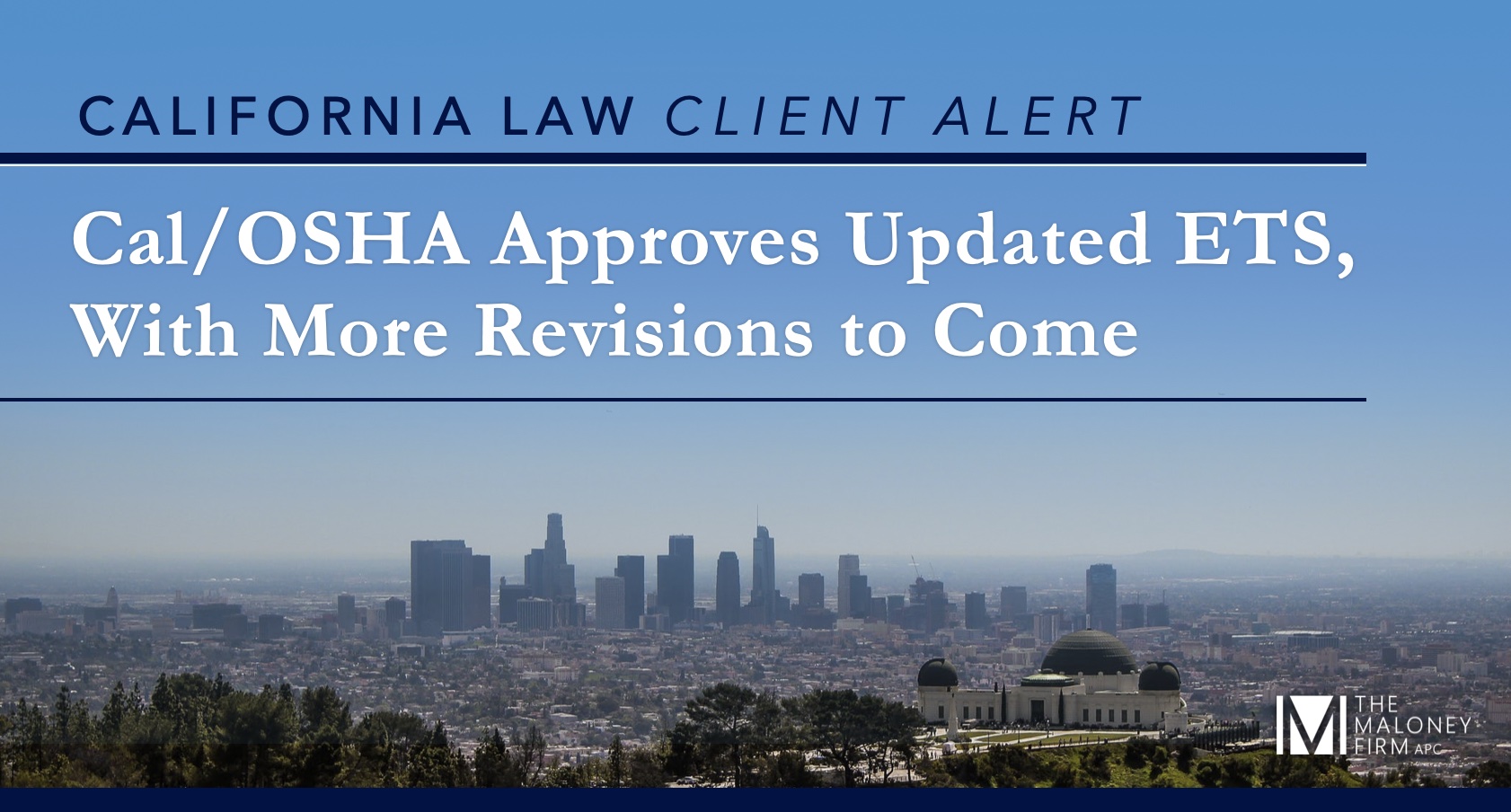Cal/OSHA Approves Updated ETS, With More Revisions to Come
Jun 05, 2021
Update: On June 9, 2021, OSHSB voted to withdraw the June 3, 2021 updates to the COVID-19 ETS (which are outlined below), and is expected to convene on June 17, 2021 to review further changes to the ETS that would bring Cal/OSHA’s guidance in line with CDC and CDPH recommendations. Read more here, and stay tuned for more updates from Cal/OSHA in the coming weeks.
.
On May 20, 2021, Cal/OSHA’s Occupational Safety & Health Standards Board (OSHSB) postponed a vote to approve proposed changes to the Emergency Temporary Standards for COVID-19 Prevention (ETS) to bring the ETS in line with CDC Guidance. After over nine hours of public commentary and deliberation on June 3, 2021, the Board voted to approve the newly revised ETS, which remain more stringent than CDC and California Department of Public Health (CDPH) guidance.
.
The revised ETS will now be submitted to California’s Office of Administrative Law (OAL) for review, and will likely be approved within the next 10 days, just before California’s anticipated June 15th reopening. During the June 3rd meeting, OSHSB indicated that employers can expect further revisions to the ETS, as well as detailed FAQs, to be released in the coming months.
.
Below is a summary of some of the most notable revisions to the ETS, which include adjustments to masking, testing, social distancing, and other requirements. As a reminder, California employers may still be subject to stricter requirements imposed by other regulatory bodies and/or local governments (such as Los Angeles County).
.
COVID-19 Prevention Measures
.
Notably, many of these provisions carry limited exemptions for fully vaccinated workers. A worker is considered “fully vaccinated” under the ETS if the employer has documentation demonstrating that the person received, at least 14 days prior, either the second dose in a two-dose COVID-19 vaccine series or a single-dose COVID-19 vaccine that is either FDA-approved or has emergency use authorization from the FDA.
.
Many provisions apply specifically to indoor worksites and “outdoor mega events,” which are events that include over 10,000 participants or spectators outdoors. These may include conventions, shows, outdoor nightclubs, concerts, sporting events, theme parks, fairs, festivals, large races, and parades.
.
Physical Distancing and Partitions
.
All physical distancing requirements are set to expire on July 31, 2021. In the meantime, for indoor worksites and outdoor mega events, employers must choose to comply with one of the following two protocols:
.
Option A: All employees must be separated from other persons by at least six feet, regardless of vaccination status, except for:
- employees wearing respirators required by the employer and used in compliance with Cal/OSHA’s respirator standard;
- where an employer can demonstrate that six feet of separation is not feasible (employees must still be as far apart as is feasible); and
- momentary exposure while persons are in movement.
Option B: All employees who are not fully vaccinated must be provided respirators for voluntary use in compliance with Cal/OSHA’s respirator standard.
.
Acceptable physical distancing methods (applicable to Option A) include:
- telework or other remote work arrangements;
- reducing the number of persons in an area at one time, including visitors;
- visual cues such as signs and floor markings to indicate where employees and others should be located or their direction and path of travel;
- staggered arrival, departure, work, and break times; and
- adjusted work processes or procedures, such as reducing production speed, to allow greater distance between employees.
To clarify, the following are exempt from physical distancing requirements:
- Employees wearing respirators required by the employer and used in compliance with Cal/OSHA’s respirator standard, and
- Locations at which all employees are fully vaccinated, except for employees who require a reasonable accommodation or exception to vaccination under federal or state law (such as FEHA, the ADA, and Title VII). For this exemption to apply, the employer must provide respirators for voluntary use in compliance with Cal/OSHA’s respirator standard to all employees who are not fully vaccinated and test those employees for COVID-19 at least once per week, during paid time and at no cost to the employees.
Until July 31, 2021, where applicable, partitions must stay in place to protect workers indoors and at outdoor mega events. After July 31, 2021, employers may remove partitions, but must reinstall them in the case of multiple COVID-19 infections or outbreaks in the workplace.
.
Testing
.
Starting July 31, 2021, employers must make COVID-19 testing available during paid time and at no cost to the employee for employees who are not fully vaccinated and have COVID-19 symptoms. This requirement applies whether or not the employee had a “close contact” with a COVID-19 case, and whether or not the exposure was work-related.
.
Employers must also make COVID-19 testing available at no cost, during paid time, to all employees who had a close contact in the workplace, except:
- Employees who were fully vaccinated before the “close contact” occurred and are asymptomatic, and
- Employees with “natural immunity” (essentially COVID-19 cases who were infected and returned to work within 90 days prior to the exposure).
Face Coverings/Masking
.
Significantly, when required, employees must use face coverings that are surgical masks, medical procedure masks, or double layered (of tightly woven or non-woven material) masks, or respirators. This does not include: scarves, ski masks, balaclavas, bandanas, turtlenecks, collars, or masks made of a single layer of fabric.
.
Employers are still required to provide face coverings and ensure employees properly wear acceptable face coverings that are clean and undamaged when indoors, when outdoors and less than six feet away from other persons, and when required by the CDPH or any local health department. However, the updated ETS adds the following exemptions:
- When an employee is alone in a room, or when all persons in a room are fully vaccinated and asymptomatic,
- Employees wearing respirators required by the employer and used in compliance with Cal/OSHA’s respirator standard, and
- Employees who are fully vaccinated and asymptomatic when they are outdoors.
The language in the updated ETS indicates that, starting June 15, if all workers in the same room are fully vaccinated and symptom-free, they are exempt from masking and physical distancing requirements. However, masks are still required when any person (which may include workers, customers, or other visitors) in a room is not fully vaccinated, regardless of other workers’ vaccination status. Therefore, California workers who interact with the public will likely be subject to face covering requirements regardless of vaccination status, even after June 15. Cal/OSHA is expected to release FAQs clarifying their masking requirements within the next few weeks.
.
After July 31, 2021, employers must provide respirators (such as N95s) to all employees who are not fully vaccinated for voluntary use. Cal/OSHA does not specify an end date for this guidance.
.
Employee Training
.
Employers are now required to provide training on COVID-19 vaccinations and testing accessibility, proper use of respirators (if they are provided for voluntary use), the differing efficacies of respirators and face coverings, and other specified topics.
.
Exclusion from the Workplace
.
Fully vaccinated and naturally immune workers do not need to be excluded from work after a close contact if they remain asymptomatic. In a change from the previous draft of the revised ETS, individuals who are COVID-19 cases, but are asymptomatic and were fully vaccinated before becoming a COVID-19 case, must be excluded from work for 10 days after the positive test.
.
Newly Revised Definitions for Close Contacts, Outbreak Testing, Mega Events
.
Fully Vaccinated
.
Employees are considered “fully vaccinated” for the purposes of this guidance when the employer obtains documentation showing that the person received, at least 14 days prior, either the second dose in a two-dose COVID-19 vaccine series or a single-dose COVID-19 vaccine. Unlike CDC guidance, which includes vaccines approved or emergency authorized by the World Health Organization, vaccines must be approved or emergency authorized by the FDA.
.
The anticipated revised ETS FAQs will likely include more information indicating how employers may comply with vaccine documentation and other medical records requirements.
.
Close Contact
.
“Close contact,” for the purposes of this guidance, is defined as being within six feet of a COVID-19 case for a cumulative total of 15 minutes or greater in any 24-hour period within or overlapping with the “high-risk exposure period” of the COVID-19 case, regardless of the use of face coverings.
.
Outbreak Testing
.
Outbreak testing is required when three or more cases within an “exposed group” visit the workplace during their high-risk exposure period within a 14-day period; the ETS revisions eliminate the requirement for outbreak testing when a workplace has been identified by the local health department as an outbreak site.
.
Exposed Groups
.
The newly revised ETS exchanges the term “exposed workplace” to “exposed group,” which is defined as:
“All employees at a work location, working area, or a common area at work, where an employee COVID-19 case was present at any time during the high-risk exposure period. A common area at work includes bathrooms, walkways, hallways, aisles, break or eating areas, and waiting areas.”
The following situations are exempt from this definition:
- A place where persons momentarily pass through while everyone is wearing face coverings, without congregating.
- The COVID-19 case was part of a distinct group of employees that are not present at the workplace at the same time as other employees (only employees within that distinct group are part of the “exposed group”).
- The COVID-19 case visited a work location, work area, or common area at work during the high risk exposure period for less than 15 minutes, during which all persons were wearing face coverings.
Resources for California Employers
.
Assuming the OAL approves the updated ETS, Cal/OSHA is expected to release FAQs clarifying the updated ETS within the next few weeks. In addition, OSHSB appointed a three-member subcommittee to convene with Cal/OSHA to draft further revisions to the ETS, which may bring the standards more in line with CDC and CDPH guidance in the coming months.
.
.
View Cal/OSHA’s Respiratory Protection Standard (Cal. Code. Regs., tit. 8, section 5144) here.
.
Employers should also be mindful of continued compliance with applicable County and/or City protocols. Los Angeles County guidance can be found here.
.
If you have questions regarding the application of Cal/OSHA’s updated ETS to your business, please contact one of the following attorneys in The Maloney Firm’s Employment Law Department: Patrick Maloney, Lisa Von Eschen, Samantha Botros, or Nicholas Grether.



